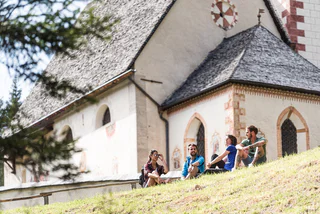
1/5
St. Jacobs church hike
Ortisei/Urtijëi/St. Ulrich/Urtijëi, Urtijëi/Ortisei, Dolomites Region Val Gardena
Všude v prázdninových regionech Jižního Tyrolska jsou vyznačeny tematické procházky, speciální objevitelské trasy pro malé i velké. Například v jihotyrolském Unterlandu mohou návštěvníci na podzim zažít, jak se hrozny dostanou z vinné révy do sudu. V San Valentinu v Campo/Gummeru můžete prozkoumat vesmír a naši sluneční soustavu a v Terlanu/Terlanu pěstitelé chřestu předvedou, jak se na jaře získává ze země vzácný chřest. Celkem na návštěvníky Jižního Tyrolska čeká více než 150 značených a poučných tematických procházek.

1/5
Ortisei/Urtijëi/St. Ulrich/Urtijëi, Urtijëi/Ortisei, Dolomites Region Val Gardena

1/9
Avigna/Afing, Jenesien/San Genesio Atesino, Bolzano/Bozen and environs

1/3
Soprabolzano/Oberbozen, Ritten/Renon, Bolzano/Bozen and environs

Proves/Proveis, Proveis/Proves, Meran/Merano and environs

Sciaves/Schabs, Natz-Schabs/Naz-Sciaves, Brixen/Bressanone and environs

Laghetti/Laag, Neumarkt/Egna, Alto Adige Wine Road

Lana di Sotto/Niederlana, Lana, Meran/Merano and environs

1/3
Prissiano/Prissian, Tisens/Tesimo, Meran/Merano and environs

San Nicolò/St. Nikolaus, Ulten/Ultimo, Meran/Merano and environs

1/3
San Vigilio, Al Plan/San Vigilio, Dolomites Region Kronplatz/Plan de Corones

San Pancrazio/St. Pankraz, St.Pankraz/San Pancrazio, Meran/Merano and environs

1/2
Gandelle-Franadega-Fienili/Kandellen-Frondeigen-Stadlern, Toblach/Dobbiaco, Dolomites Region 3 Zinnen

S. Maddalena/St. Magdalena - Casies/Gsies, Gsies/Valle di Casies

Sciaves/Schabs, Natz-Schabs/Naz-Sciaves, Brixen/Bressanone and environs

1/3
Valgiovo/Jaufental, Ratschings/Racines, Sterzing/Vipiteno and environs

1/3
S. Genesio Atesino/Jenesien, Jenesien/San Genesio Atesino, Bolzano/Bozen and environs

Ciardes/Tschars, Kastelbell-Tschars/Castelbello-Ciardes, Vinschgau/Val Venosta

1/6
Siusi/Seis, Kastelruth/Castelrotto, Dolomites Region Seiser Alm

1/3
Obereggen/Obereggen, Deutschnofen/Nova Ponente, Dolomites Region Eggental

1/3
Maranza/Meransen, Mühlbach/Rio di Pusteria, Brixen/Bressanone and environs

1/8
Oris/Eyrs, Laas/Lasa, Vinschgau/Val Venosta

1/2
Villa Ottone/Uttenheim, Gais, Dolomites Region Kronplatz/Plan de Corones

Campolino/Lothen, St.Lorenzen/San Lorenzo di Sebato, Dolomites Region Kronplatz/Plan de Corones

Laag/Laghetti, Neumarkt/Egna, Alto Adige Wine Road

1/2
Auna di Sopra/Oberinn, Ritten/Renon, Bolzano/Bozen and environs

1/5
Corvara/Rabenstein, Moos in Passeier/Moso in Passiria, Meran/Merano and environs

1/2
Fundres/Pfunders, Vintl/Vandoies, Brixen/Bressanone and environs

Valgiovo/Jaufental, Ratschings/Racines, Sterzing/Vipiteno and environs

Trafoi/Trafoi, Stilfs/Stelvio, Vinschgau/Val Venosta

Casere/Kasern, Prettau/Predoi, Ahrntal/Valle Aurina